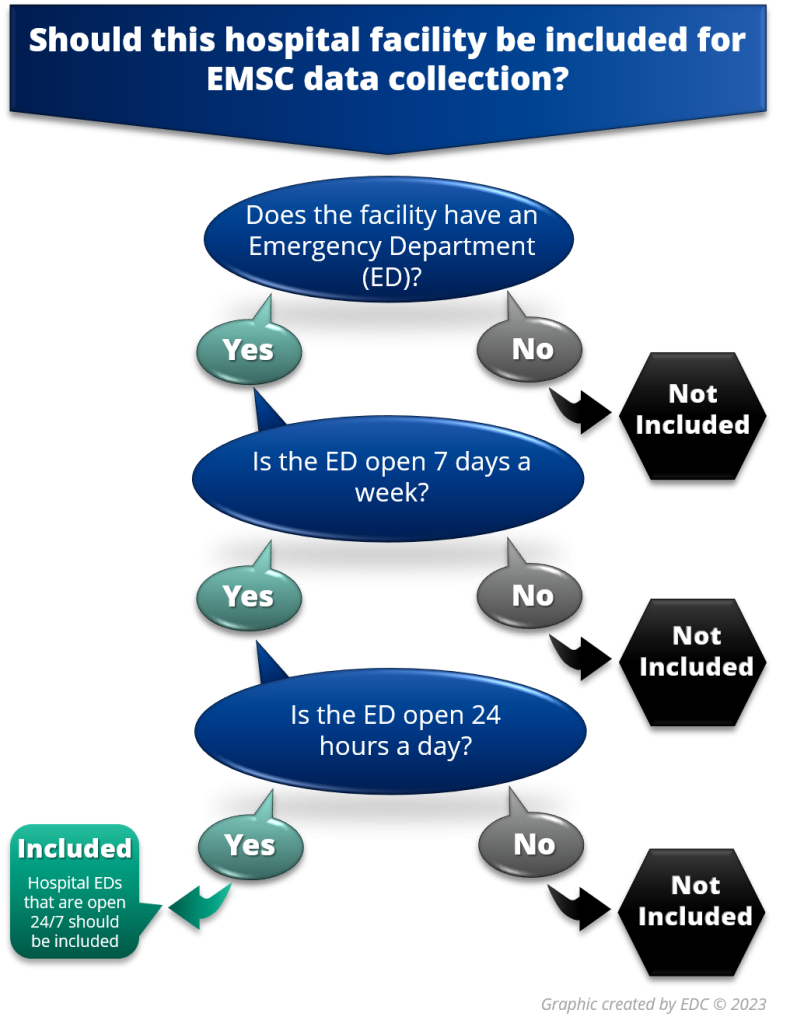National Pediatric Readiness Project (NPRP) Assessment
This section is written as a resource specifically for EMSC Program Managers and Project Directors in mind – or whomever will be managing the data collection for the state/territory. To read more about the National Pediatric Readiness Project, please visit the pediatric readiness website.
What is it?
The National Pediatric Readiness Project Assessment is part of a national multi-phase quality improvement initiative to assess hospital emergency department’s (ED) readiness to treat pediatric patients based on the following domains derived from the 2018 joint policy statement called Pediatric Readiness in the Emergency Department:
- Administration and Coordination for the Care of Children in the ED
- Competencies for Physicians, Advanced Practice Providers, Nurses, and Other ED Health Care Providers
- QI and/or PI in the ED
- Policies, Procedures, and Protocols for the ED
- Pediatric Patient and Medication Safety in the ED
- Equipment, Supplies, and Medications
Frequently Asked Questions
The rest of this page is organized to address the most frequently asked questions we receive from EMSC Program Managers and Project Directors about deploying this assessment and the data collection.
1. Which hospital EDs should be surveyed for this data?
This assessment collects data for EMSC performance measures 1.2, 1.3, and 1.4 and therefore uses the same hospital definition. According to the definition in the 2023 EMSC Performance Measure Implementation Manual, a hospital is defined as a facility that provides definitive medical or surgical assessment, diagnoses, and life- and limb-saving interventions for the ill and injured and have an Emergency Department (ED) open 24/7. The assessment is intended to be completed by the ED nurse managers (or equivalent) who has day-to-day knowledge of operations.
A list of these hospital EDs for each state/territory with designated contact is in the EDC’s secure online Contact List Management System (CLMS). EMSC Program Managers have 24/7 access to the CLMS for updating, verifying, and managing their list of hospital EDs as well as the contact information.
The list of hospital EDs in CLMS is vital for the data collection because it populates the assessment website and some of the secure Tableau dashboards. Before each data collection begins, EDC staff will prepare a data quality report showing any data issues in your hospital ED list like missing contact information which is needed for deployment. Links to the secure CLMS and Tableau systems for Program Managers can be found on our EDC & TA section under the Program Manager Secure Login at the bottom of the page.

2. Is there a minimum required response rate?
Similar to the EMS for Children Survey and PPRP Assessment, the goal is an 80+% response rate. The higher the response rate a state/territory receives, the more confidence they have that the results are representative of ED pediatric readiness in their state/territory.
The number of hospital EDs per state/territory that meet the Program’s definition varies; therefore, so does the amount of effort for the data collection.

3. What is the data collection cycle and schedule for this assessment?

The last National Pediatric Readiness Project (NPRP) Assessment occurred in 2021. According to current Program plans, the expectation is that the NPRP Assessment will occur every 5 years, so the next assessment will be in 2026.
Before the assessment opens, it will be preceded by Program Managers updating and verifying the hospital ED contact information listed in CLMS. EDC staff will help Managers with this part of the process by creating state/territory specific data quality reports of this information and show the data quality issues in the reports. Data quality issues can include missing contact information and/or information being in all capital letters or all lower-case letters. Promotion of the assessment will also be an important part of the prep work. Managers can find marketing materials for this assessment on our website under the Survey and Assessment Promotional Materials section.
Once the assessment opens, hospital EDs typically have 3-4 months to complete the 30-45 minute assessment. Once an assessment has been completed for a hospital ED, their name is greyed out and becomes inactive on the assessment website to decrease duplication of effort. Managers can monitor respondent and non-respondent hospital EDs in secure Tableau dashboards.
The assessment generally closes the last day of the month of the data collection period. After the assessment has closed, EDC staff export the estimated 4,000+ responses. EDC staff then spend 1 to 2 months cleaning the data and preparing the final dataset for analysis. Cleaning and preparation include removing duplicates or incomplete responses and ensuring addresses are formatted in proper form for geographic analysis (urbanicity). Preliminary analysis is conducted while the data is geo-coded (latitude, longitude, census information, and urbanicity). The initial task of the EDC is to report national and state/territory performance measure results, hopefully within 2 months of the assessment close. Further and more in-depth analysis and programming for various secure Tableau dashboards for all responses and QI purposes starts approximately 3-5 months after the assessment has closed.
The months following the release of Tableau dashboards are used by Managers to share their results and educate hospital EDs to effect improvement in the domains listed above. Managers can find resources for these activities on our website under the Survey and Assessment Promotional Materials section.
4. Who sends the assessment invitation and reminders?

The NPRP and assessment is a collaboration of national organizations in which EMSC is a partner. The assessment is a national quality improvement effort requiring centralized national deployment for improved data quality, integrity, and comparability.
Unlike the EMS for Children Survey, for the NPRP Managers do NOT get a choice of who sends the assessment invitations and reminders. On behalf of the federal EMSC Program, EDC staff will manage sending the invitations and reminders for this national assessment. The number and frequency of these communications will be founded on evidence-based survey deployment methods to ensure data quality, integrity, and comparability.
5. How many and when should I send assessment communications?

On behalf of the federal EMSC Program, EDC staff typically sends 5 communications to hospital EDs to complete the assessment. These communications usually consist of a pre-notice announcement, an initial invitation, and then three reminder announcements. The number and frequency of these communications will be based on evidence-based survey deployment methods to ensure data quality, integrity, and comparability.
While Managers will not be sending the invitation and reminders, they will be an important part of promotion, which could include sending additional communications and calling non-respondent hospital EDs.
6. How or where can I customize the assessment for EMSC data collection?
The simple answer is that you cannot change any wording in the assessment for your EMSC data collection.
Please keep in mind this is a national quality improvement assessment supported by the federal EMSC Program. As such, it was subject to strenuous review and approval by the NPRP Steering Committee made up of over 20 subject matter experts. As part of their review and approval process, the NPRP Steering Committee pilot tested the survey questions with various hospital EDs across the US and conducted one-on-one cognitive interviews with these participating hospital EDs. The assessment development, review, and approval process took a little over 2 years.
You can download a PDF version of the assessment from our website.


